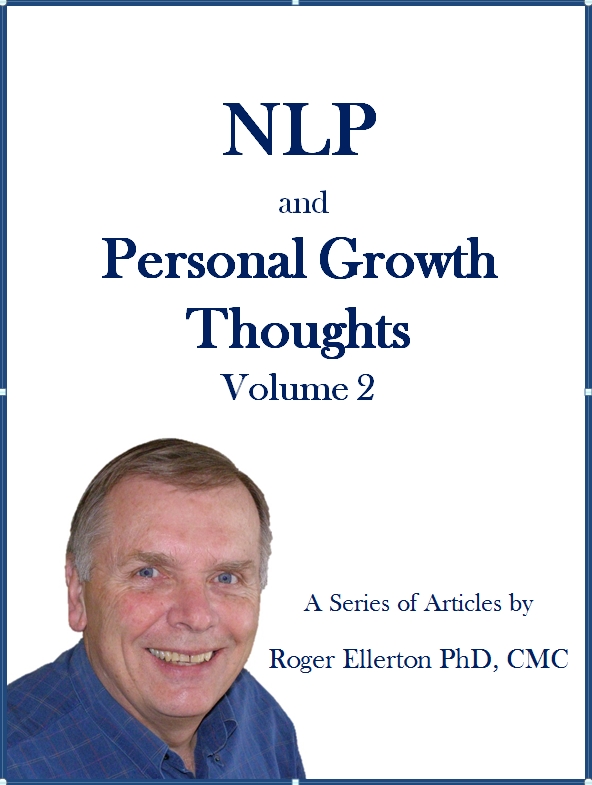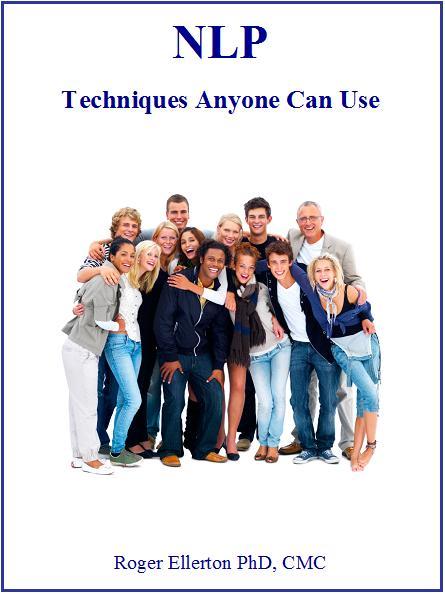NLP Meta Model
By Roger Ellerton Phd, ISP, CMC, Renewal Technologies Inc.
This article may not be republished without written permission from Roger Ellerton/Renewal Technologies Inc. If you republish this article without permission, you will be in violation of copyright law and sent an invoice. You may share this and other pages with your friends by linking directly to this page from your website or blog.
Deep Structure and Surface Structure
At a deep level of thought, a speaker has complete knowledge of what he wishes to communicate to someone else. This is called the deep structure and operates at an unconscious level. To be efficient in his verbal or written communication, the speaker unconsciously deletes, generalizes or distorts his inner thoughts based on his beliefs and values, memories, decisions (limiting), strategies, what he wants you to hear, etc. What is finally said, communicated through body language or written (surface structure) is only a small subset of the original thought and may be ambiguous or confusing and lead to miscommunication.
To illustrate deep structure and surface structure and why it is important to be aware of the distinction, let's assume you are my business coach. Before saying or writing a word and often in a blink of an eye, my inner thoughts (deep structure) are unconsciously filtered through my model of the world (beliefs and values, etc.). I then say to you, "My boss doesn't appreciate what I do." - The surface structure of my communication. You, as my business coach (assuming you are not well-trained) take in my words and at a deep level of thought (your deep structure), filter what I have said through your beliefs and values, memories, decisions, ... . Then you may say (surface structure) something such as "I know exactly what you are saying and here is what you should do." Your advice may be most appropriate for you and most inappropriate for me, as you have no real understanding as to what I mean by "My boss doesn't appreciate what I do." As a result, this may lead to us having an argument because I feel you do not understand me and are always telling me what to do and I may become more entrenched in continuing with my limiting beliefs and behaviours. To be an effective coach, you need to get curious about what I have said and to ask questions for both of us to gain a better appreciation of my deep structure. Once we have this clarity, you are in a better position to provide advice. What often happens is that when I, as the client, get clarity on the issue and what needs to be done, I do not need your advice, but simply your continued support and curiousity. In other words, as a coach you need to help me discover the path from my surface structure to my deep structure of language through questioning.
The Meta Model provides us (as coaches, bosses, therapists, family members, friends, ...) with a set of questions to assist the person we are helping (client) to move from the surface structure of his communication to an understanding of his deep structure - unconscious beliefs, values, decisions. This is not about finding the right answers but having a better understanding of your client's model of the world.
Origin of the Meta Model
John Grinder and Richard Bandler developed the Meta Model by modeling two very successful therapists, Fritz Perls and Virginia Satir, who got extraordinary results from their clients by having them be more specific in what they expressed. That is, by using certain types of questions to gather information (gain understanding of the client's deep structure). Grinder and Bandler observed that in moving from the deep structure to the surface structure, people unconsciously:
- Delete: We only present some of the information available at the deep structure.
- Generalize: We may make general statements about what we believe, how we see others, our values, etc. We ignore possible exceptions or special conditions.
- Distort: We may choose to over simplify or fanaticize about what is possible or what has happened.
To recover the information missing as a result of deletions, generalizations and distortions, Grinder and Bandler identified 12 different patterns with corresponding questions and called this the Meta Model. The Meta Model is about being more specific (chunking down) to get a better understanding of the person's model of the world. All human communication has the potential to be ambiguous. The purpose of the questions is to cut through this ambiguity, which may cause problems, and to access the missing information for both the client and the coach, i.e. to gain a better understanding of the client's deep structure and to make better sense of the communication.
Although based on the work of two therapists, the Meta Model has much wider application - wherever two or more people are engaged in communicating - at work, at play, within the family, etc.
Once mastered, the Meta Model is a powerful and useful tool. However, it does take practice to master the questioning process and the process must be undertaken with a high degree of rapport - the client must feel safe and not pressured. Before asking any of my clients, students, colleagues, family members, etc. the Meta Model questions, I make sure that they are comfortable in my presence, have a feeling of safety and I ask them the following: "May I ask you a question?" If they respond 'no', then I do not use meta model questioning. Instead, I put more effort in listening to the presuppositions (what is presupposed) in the words they choose in order to get a clearer understanding of their model of the world and how I can best interface/support them.
Meta Model
Deletions
Simple Deletion: Something is left out.
Example: "I am mad."
Question(s) to recover lost information: "About what?"
Unspecified Referential Index: The person(s) or object to which the statement refers is unspecified or not clear.
Example: "They rejected my business proposal." or "They rejected it."
Question(s) to recover lost information: "Who?" or "What?"
Comparative Deletions: A comparison is made and it is unclear as to what is being compared. The sentence will contain words such as: good, bad, better, best, worst, more, less, most, least.
Example: "This approach is better."
Question(s) to recover lost information: "Compared to what or whom?"
Unspecified Verb: In this case, it is not clear how something was done.
Example: "They rejected my business proposal." I have used the example for Unspecified Referential Index to illustrate that sometimes there are several things that have been deleted, distorted or generalized and it is up to you to decide which line of questioning will yield the most information.
Question(s) to recover lost information: "How specifically?"
Nominalizations: A process has been turned into a "thing". Nominalizations are nouns, yet you cannot physically touch them or put them in the trunk of your car. Examples of nominalizations are: communication, relationship, leadership, respect, truth, freedom, depression, love, etc. Our task here is to ask a question so that the process can be rediscovered.
Example: "The communication in our family is poor."
Question(s) to recover lost information: "How would you like us to communicate?" Notice that there is also a comparative deletion and we could also ask "Poor compared to what?"
Generalizations
Universal Quantifiers: Universal quantifiers are typically words such as: all, every, never, always, only, everyone, everything, no one, etc.
Example: "My boss never gives me credit for what I do."
Question(s) to recover lost information: We can exaggerate the generalization or use a counter example. "Never?" or "Has there ever been a time when your boss has given you credit?"
Modal Operators of Necessity or Possibility: Modal Operators of Necessity include words such as should, shouldn't, must, must not, have to, need to, it is necessary. Modal Operators of Possibility include words such as can/can't, will/won't, may/may not, possible/impossible.
Example: "I can't do this now."
Question(s) to recover lost information: The key is to challenge the limitation. "What would happen if you did?" or "What prevents you?"
Distortions
Mind Reading: In this case, the speaker claims to know what another person believes, feels, or thinks.
Example: "My boss is not pleased with my work."
Question(s) to recover lost information: For this pattern, we simply ask, how do you know? "How specifically do you know your boss is not pleased with your work?"
Lost Performative: Value judgments are made and it is not clear who has made the judgment.
Example: "This is the right way to get ahead in this company."
Question(s) to recover lost information: "According to whom?" or "How do you know it is the right way?"
Cause - Effect: The speaker establishes a cause-effect relationship between two events or actions. Common constructions include: if .., then, because, makes, compels, causes.
Example: "When you look at me that way, I feel unimportant."
Question(s) to recover lost information: "How does the way I look at you cause you to choose to feel unimportant?" You could also use a counter example.
Complex Equivalence: In this situation two experiences are interpreted as being synonymous. These two experiences could be joined by words such as: therefore, means, implies.
Example: "My boss walked into his office without saying 'good morning', therefore he is not pleased with my work."
Question(s) to recover lost information: "How does not saying 'good morning' mean that your boss is not pleased with your work?" or "Have you ever been preoccupied by family or business pressures and forgot to say 'good morning' to your co-workers?"
Presuppositions: Some part of the sentence presupposes or implies the existence (or non-existence) of something, person, etc. while not explicitly stating it.
Example: "When will you demonstrate leadership for your team?" This sentence presupposes that you do not demonstrate leadership. If you try to answer this question directly, you will be digging an even deeper hole for yourself.
Question(s) to recover lost information: "What leads you to believe that I do not demonstrate leadership?" or "How is it that I do not demonstrate leadership?"
Avoid asking 'Why'
The questions in the Meta Model do not have any 'why' questions. When you ask someone a 'why' question, often they feel they have to defend what they have said or done, make excuses or rationalize their behaviour. On the other hand, if you expressed the question as a 'how' question, then you get a better understanding of the process used by your client and thus more information and understanding.
And NLP is Much more than that!
Author: Roger Ellerton is a certified NLP trainer, certified management consultant and the founder and managing partner of Renewal Technologies. The above article is based on his book Live Your Dreams Let Reality Catch Up: NLP and Common Sense for Coaches, Managers and You.
Copyright © 2004, 2015 Renewal Technologies Inc. All rights reserved.








